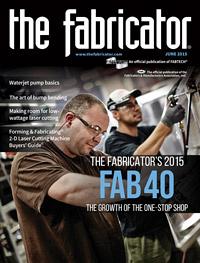Senior Editor
- FMA
- The Fabricator
- FABTECH
- Canadian Metalworking
Categories
- Additive Manufacturing
- Aluminum Welding
- Arc Welding
- Assembly and Joining
- Automation and Robotics
- Bending and Forming
- Consumables
- Cutting and Weld Prep
- Electric Vehicles
- En Español
- Finishing
- Hydroforming
- Laser Cutting
- Laser Welding
- Machining
- Manufacturing Software
- Materials Handling
- Metals/Materials
- Oxyfuel Cutting
- Plasma Cutting
- Power Tools
- Punching and Other Holemaking
- Roll Forming
- Safety
- Sawing
- Shearing
- Shop Management
- Testing and Measuring
- Tube and Pipe Fabrication
- Tube and Pipe Production
- Waterjet Cutting
Industry Directory
Webcasts
Podcasts
FAB 40
Advertise
Subscribe
Account Login
Search
The 2015 FAB 40: The largest custom metal fabricators grow even bigger
Revenues reported by the FAB 40 continue to climb, but will this trend continue?
- By Tim Heston
- June 3, 2015
- Article
- Shop Management
In 2011 the top company in the FAB 40 reported 2010 revenue of $111 million. This year that same fabricator, Mayville, Wis.-based Mayville Engineering Co. Inc. (MEC), remains the No. 1 company on the FAB 40, reporting 2014 revenue of $335 million. Through organic growth and acquisitions, the company has more than tripled in size during the past four years.
While MEC stands out, it isn’t alone. Other companies in this year’s list have grand plans of growth. As just one example, the president of Millenia Products Group said within a few years he expects the company to earn $250 million. For a company that reported 2014 revenue of $76 million, that’s saying something.
Among the FAB 40’s three largest fabricators, revenue growth between 2013 and 2014 averaged 15 percent. For custom fabricators that earn well more than $100 million annually, that’s also saying something.
Such optimism isn’t surprising considering the current dealmaking environment. In a presentation at the 2014 FABTECH® show in Atlanta, Doug Nix, vice chairman of Corporate Finance Associates in Oakville, Ont., Canada, said that the amount of cash in global business has reached record levels, which in turn may have a dramatic effect on M&A during the coming years. “There’s an incredible amount of liquidity—that is, cash—in the system,” he said.
How will this shape the custom fabrication business in the years to come? This year’s FAB 40 list provides a few clues.
Ripe for Consolidation, or Not?
The FAB 40 is The FABRICATOR’s attempt to provide a snapshot of metal fabrication in the U.S. By collecting this information, we hope to give metal fabricators an idea of how some of the leading shops performed financially last year, and what they are forecasting for the current year. For more information on how this list was compiled, see the Delivering the FAB 40 sidebar.
Investors might look at this list and see an industry ripe for consolidation, and in some markets this certainly may be the case. Many OEMs are reducing the number of shops they work with and awarding more contracts to their preferred suppliers. In such an environment, bigger would seem to be better, especially when it comes to revenue diversification. So many fabricators want to broaden their customer bases. Yet diversification remains a continual challenge, simply because current customers are giving the best fabricators more and more work.
In these cases, it would make sense for companies to combine forces, and some are doing so in unconventional ways. Service centers have offered some level of custom fabrication for years, and some are expanding even further down the supply chain. Our No. 2 company, O’Neal Manufacturing Services (OMS), is the distribution giant’s contract manufacturing arm. Millenia Products Group, our No. 7 company, launched in 2001 as a distributor but with a strategy to expand into manufacturing, including stamping, custom fabrication, and complete assembly. Today contract manufacturing makes up most of Millenia’s revenue.
A Complex Business
So what’s the argument against consolidation? Again, the FAB 40 list provides some clues. First, custom fabrication is an extraordinarily horizontal industry. Fabrication touches an amazing number of sectors that demand amazingly different products, from the smallest automotive parts to the largest industrial assemblies. Each custom fabricator has a unique product mix that changes over time. This sets the stage for some complex business planning.
This becomes evident when you look at revenue growth between 2013 and 2014. Growth numbers average in positive territory, but the range is extremely wide. This may again go back to revenue concentration. If a top customer sends more work or slows down, the fabricator’s top line follows suit. Revenue growth for the top seven FAB 40 companies alone (that is, those that submitted revenue for this and last year’s FAB 40) ranged from positive 27 percent to negative 13 percent. A few companies, including some industrial and specialty fabricators that specialize in large projects, experienced even wider revenue swings between 2013 and 2014. When a large industrial fabricator lands a large project, revenue climbs in a hurry.
The product mix within just one operation can run the gamut. You have one-off jobs; blanket orders; intercompany kanban and similar replenishment relationships; and complete contract manufacturing with drop-shipped products, where customers never touch the order. The variety of services is astounding.
This also makes the nature of each business unique. If you do a rough calculation of sales per employee based on the list that follows (though note that fabricators were not asked to provide full-time-equivalent head counts), you’ll get a wide range of figures, mainly because fabricators work with vastly different material and purchased component costs. Some on the high end purchase a lot of components for large construction projects, and such large, project-based fabrication is vastly different from a dozen lasers cutting tens of thousands of piece parts a week.
Then comes increasing demands from customers. Quality is a given for any successful fabricator, but in the preferred supplier arena, OEMs expect world-class delivery as well. In the past some customers may have put up with late deliveries, if they got a deal on the price. That won’t be the case forever, though.
As companies grow, the number of different products can increase dramatically, and each may require different routings, different purchased components, different outsourced processes, and different levels of engineering. Anyone in this business needs to be quite the juggler.
Still, the best fabricators are getting to be extraordinarily skilled jugglers. They’ve done this by implementing continuous improvement and continuing to invest in technology, including software and machinery. These strategies help build excess capacity so that fabricators can handle demand variability. Ideally, these improvements can help them meet increasing demands from existing customers while still bringing in new ones. Moreover, a bigger company can offer more career paths for ambitious people wanting to climb the ladder.
But bigger isn’t always better. There’s something extremely American about the small, independent shop. The nature of so much manufacturing work is either extremely low volume or one-off—no blanket orders, no consistent demand. As long as the U.S. has entrepreneurs with an idea, people who want just one of this or a dozen of that, small job shops will continue to dominate metal fabrication.
Nevertheless, large custom fabricators, especially those with multiple locations, are helping OEMs mitigate risk. Why should an OEM expand its own manufacturing when a reliable supplier, one not tied to the ups and downs of just one market, has the product design and fabrication expertise, not to mention the technology, to meet the OEM’s demand? As more design and manufacturing responsibility is being pushed down the supply chain, custom fabrication’s largest players probably will continue to grow even larger.
About the Author

Tim Heston
2135 Point Blvd
Elgin, IL 60123
815-381-1314
Tim Heston, The Fabricator's senior editor, has covered the metal fabrication industry since 1998, starting his career at the American Welding Society's Welding Journal. Since then he has covered the full range of metal fabrication processes, from stamping, bending, and cutting to grinding and polishing. He joined The Fabricator's staff in October 2007.
subscribe now

The Fabricator is North America's leading magazine for the metal forming and fabricating industry. The magazine delivers the news, technical articles, and case histories that enable fabricators to do their jobs more efficiently. The Fabricator has served the industry since 1970.
start your free subscription- Stay connected from anywhere

Easily access valuable industry resources now with full access to the digital edition of The Fabricator.

Easily access valuable industry resources now with full access to the digital edition of The Welder.

Easily access valuable industry resources now with full access to the digital edition of The Tube and Pipe Journal.
- Podcasting
- Podcast:
- The Fabricator Podcast
- Published:
- 04/16/2024
- Running Time:
- 63:29
In this episode of The Fabricator Podcast, Caleb Chamberlain, co-founder and CEO of OSH Cut, discusses his company’s...
- Trending Articles
How to set a press brake backgauge manually

Capturing, recording equipment inspection data for FMEA

Tips for creating sheet metal tubes with perforations

Are two heads better than one in fiber laser cutting?

Hypertherm Associates implements Rapyuta Robotics AMRs in warehouse

- Industry Events
16th Annual Safety Conference
- April 30 - May 1, 2024
- Elgin,
Pipe and Tube Conference
- May 21 - 22, 2024
- Omaha, NE
World-Class Roll Forming Workshop
- June 5 - 6, 2024
- Louisville, KY
Advanced Laser Application Workshop
- June 25 - 27, 2024
- Novi, MI



























